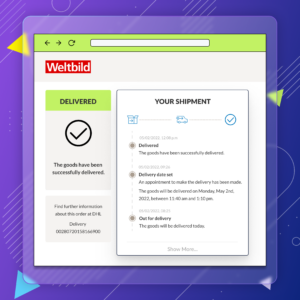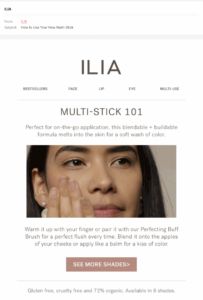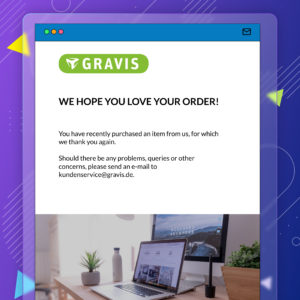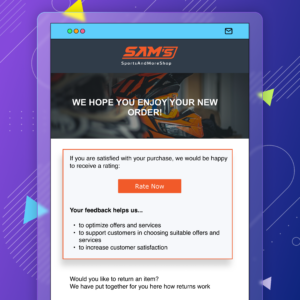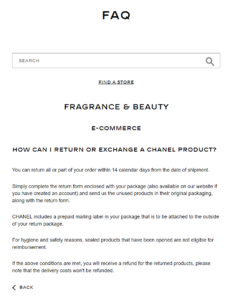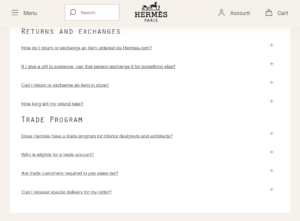High return rates can harm profitability, disrupt inventory management, and even affect brand reputation. And in an industry where customers have higher expectations, it’s vital for luxury ecommerce businesses to tactfully navigate this landscape.
This guide will show you exactly how to do just that. You’ll learn how to craft a stellar return policy, improve post-purchase customer service, and ultimately decrease luxury ecommerce returns.
Let’s get started.
The impact of luxury ecommerce returns
| Negative impact of returns | Description |
|---|---|
| Decreased profits | Brands must spend to inspect and restock products. There are also costs surrounding reverse logistics and shipping |
| Reputation damages | Returns may signal that products are not meeting the standards expected from luxury brands |
| Operational disruption and complexity | Returns add a layer of complexity on supply chain and inventory management, as well as general retail operations |
| Sustainability concerns | Unsold products and their packaging can sometimes end up in oceans and landfills; transporting returned products also leads to increased energy consumption and carbon emissions |
Luxury ecommerce returns can have a detrimental impact on various areas of your business. Consider the following.
Decreased profits
Let’s start with the most obvious: product returns harm your profits. Numerous direct costs come with processing returns; products must be inspected, restocked, and repackaged—and these actions require labor and material costs. In many cases, brands must navigate through the complexities of reverse logistics and pay for shipping costs.
And let’s not forget that some items cannot be resold, which means brands suffer from additional losses.
Reputation damages
Your brand reputation can also take a hit when returns occur too frequently.
Remember that luxury brands are synonymous with high quality. When shoppers return their purchases, it signals that products are not meeting the expected standards. This perception can tarnish your image over time, especially if customers share their experiences publicly on social media or review sites.
Operational disruption and complexity
Luxury goods, often produced in limited quantities, can be particularly sensitive to inventory disruptions. High return rates and fluctuating stock levels cause disruptions in stock management as predicting inventory needs becomes more challenging.
Plus, the added work of inspecting products, managing supply chain logistics, and increased admin work leads to inefficiencies in your back office and beyond.
Sustainability concerns
Returns in luxury ecommerce contribute to sustainability concerns in several ways. Returns lead to increased energy consumption and carbon emissions since each delivery must be transported back to your warehouse by air or road.
There’s also the matter of waste. Every product shipped requires extra packaging—which can end up in oceans and landfills. Returned products typically need to be repackaged for resale, doubling the amount of packaging used. In the luxury segment, packaging tends to be more elaborate (and often less eco-friendly) to align with the premium unboxing experience, exacerbating this issue.
Finally, there’s product waste. Some items may not be eligible for resale; when this happens, brands dispose of unsold merchandise.
The cost of luxury ecommerce returns
While there’s limited research explicitly done on luxury ecommerce returns, we can infer several things from available industry data. According to Chain Store Age, returns cost online retailers around 21% of the order value, and ecommerce return rates are around 20.8%.
The numbers are even more concerning for apparel brands (a large segment of luxury purchases). Data from Coresight Research shows that the online apparel return rate is 24.4%, which translates to $38 billion in returns.
These numbers are enormous, and they demonstrate the importance of an effective return management strategy in luxury ecommerce. Curbing returns is an absolute must if you want to protect your margins, brand reputation, and even the environment.
Optimizing post-purchase: How can post-purchase engagement prevent returns?
One of the best ways to manage luxury ecommerce returns is to prevent them from happening in the first place. This can be done by optimizing the post-purchase experience. You can significantly reduce the likelihood of returns by engaging customers effectively after the purchase, and providing clear communication on product care, potential troubleshooting, and proper usage.
Kick things off on the right foot by sending prompt order updates and . There are different components to this, including:
Order confirmation
Once a customer purchases something, send an order confirmation email ASAP to give them an opportunity to review their order details. This way, they can quickly spot and rectify any errors before the order is shipped, reducing the likelihood of returns due to incorrect products or variations.
Shipping status
Proactive communication about shipping status help ensures that customers are available to receive their packages. Doing so lowers the chances of failed delivery attempts. It also helps to build anticipation and reduces the chance of buyer’s remorse.
is one example of a brand that does an excellent job of keeping customers in the loop from the moment they purchase something (order confirmation) all the way to . Weltbild uses parcelLab to communicate with shoppers throughout every stage of the post-purchase experience, ensuring they’re updated with where their orders are.
Weltbild’s efforts enabled the brand to connect better with customers, which resulted in a 5% decrease in returns.
“Thanks to parcelLab, we were able to improve customer communication and make it more transparent,” says Christian Sailer, Chairman of the Management Board at Weltbild. “Weltbild puts its customers center stage across the entire customer journey – no matter where they are at the time. This gives them an all-round good shopping experience.”
Product tips and information
After a product is delivered, consider sending follow-up communications on how to use, maintain, or install the product. Doing so can prevent returns resulting from user error or misunderstanding.
For example, in luxury ecommerce, if a customer is unsure how to apply a high-end cosmetic product, they might return it out of fear of misusing it. Providing clear application instructions or tutorials can alleviate this concern.
Take a look at this example from ILIA, which provides clear application instructions for its multi-stick product.
Keep an open line of communication
Keeping the lines of communication open post-purchase shows customers that you care about their experience and satisfaction. If someone is dissatisfied or encounters an issue, they can contact customer service for assistance before deciding to return the product.
GRAVIS, Germany’s largest provider of Apple products, promotes open communication at the post-purchase stage by encouraging customers to reach out if they encounter any issues. Once an order has been delivered, GRAVIS sends a notification email, along with a quick note to contact the brand should questions or problems arise.
GRAVIS has experienced remarkable outcomes with the help of parcelLab. Incorporating feedback requests into their interactive post-checkout emails resulted in a dramatic surge in customer reviews—a whopping 127% increase, to be precise.
Ask for feedback
Speaking of customer reviews, don’t shy away from asking for feedback. Collecting customer input provides valuable information to the business and allows customers to voice any concerns or issues they may have encountered. This can act as an early warning system for potential returns, and problems can be resolved before a return is initiated.
You can easily incorporate feedback collection into the post-purchase journey. Check out this example from SportsAndMore (SAM), an online sporting goods and clothing store. SAM uses parcelLab to collect customer reviews quickly.
Once an order has been delivered, SAM automatically requests feedback via email.
Doing so has led to a lift in positive reviews and engagement. Since using parcelLab, SAM has seen open rates increase by 70%.
“One impact we didn’t even have on our radar before was the many positive customer reviews we’ve received since we started using the parcelLab solution. In particular, they praise the communication during shipping,” shares Marco Hörmann, IT Manager at SAM.
Crafting an effective return policy for luxury ecommerce
While there are a lot of things you can do to prevent luxury ecommerce returns (see above), it’s impossible to eliminate them completely. That’s why crafting a return policy that informs shoppers about the requirements and steps involved in returning a product is essential.
Implementing an effective policy is the first step to streamlining product returns. Here are tips on how to do just that.
Have clear and transparent policies
Luxury brands are associated with superior quality, impeccable service, and customer satisfaction. A clear and transparent return policy is integral to upholding these values. Customers purchasing luxury items make a significant investment, so they want the reassurance that if the product doesn’t meet their expectations, there’s a fair and understandable process to make it right.
A well-defined return policy provides helps accomplish this. Plus, transparency in return policies prevents misunderstandings and disputes, which can damage your brand reputation.
Look at Chanel’s ecommerce return policy for fragrance and beauty products. Chanel’s guidelines are written in a straightforward and easy-to-understand manner, which eliminates ambiguity. There are also clear instructions on initiating returns (something that can be done online).
Consider making returns complimentary
Luxury brands command premium prices; therefore, customers expect a high-end, hassle-free experience—including returns. By providing free returns, you align with these high customer expectations, reinforcing the superior level of service synonymous with luxury.
Not to mention, complimentary returns reduce the barriers to purchase. Shoppers may hesitate to buy expensive items online due to uncertainty about fit, feel, or appearance. When returns are free, it alleviates this concern, and customers are more likely to make a purchase they might have otherwise postponed.
One example of a luxury brand offering free returns is Hermes. The company states this clearly on its website, so shoppers are reassured that they won’t be charged for returns.
Promote convenience
A high-end returns experience is also a convenient one. As such, luxury ecommerce returns should be easy, fast, and seamless. Depending on your brand, this can mean allowing customers to return products in-store and online to eliminate friction from the process.
Take, for instance, Gucci, which allows returns to be made by mail or in-store. Customers can start the process through their online account or by contacting a Client Advisor.
Final words
Managing and reducing returns in the luxury ecommerce segment involves:
- Optimizing post-purchase engagement
- Crafting an effective return policy
- Harnessing the power of feedback and open communication to mitigate the potential for returns
We hope this guide provided a roadmap to do all that, so you can successfully navigate the complex landscape of returns. If you’re interested in learning more about what the top luxury brands are doing to stand out, check out Forrester’s Digital Go-To-Market Review: Luxury Fashion Brands.
And if you need a solution that can facilitate the returns process, be sure to check out parcelLab. Our post-purchase experience platform helps reduce returns, recover revenue, and simplify your operations. Book a demo today.
Written by


